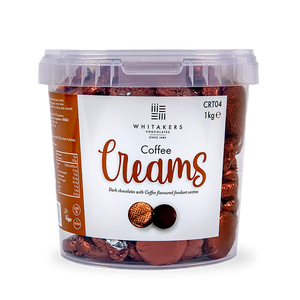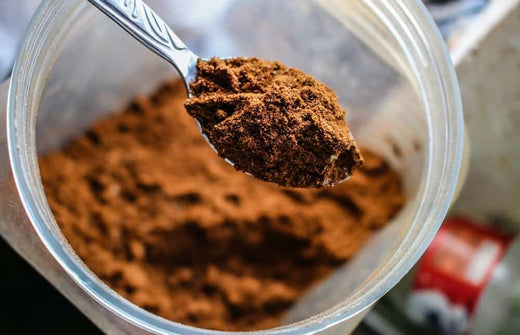Cacao powder isn't your average cocoa powder; it's a nutrient-rich, unprocessed gem that hails from the cacao bean, offering a wide range of potential health benefits.
This post will look into raw cacao powder, distinguishing it from its more commonly known counterpart, cocoa, and exploring why it might deserve a space in your kitchen.
So get yourself comfy with a cuppa, and let's embark on this chocolatey journey together.
What Is Raw Cacao Powder?
Raw cacao powder comes from the cacao bean, the same bean from which all chocolate originates.
Unlike cocoa powder, which undergoes a high-temperature roasting, raw cacao is made by cold-pressing unroasted cocoa beans.
This means it retains more natural nutrients, antioxidants, and enzymes.
Apart from its richer nutritional profile, one of the most notable differences is its flavour.
Raw cacao tends to taste more intensely and slightly bitter than traditional cocoa.
But this depth of flavour makes it a favourite for many artisanal chocolatiers and home bakers.
In essence, raw cacao powder is a less processed, more nutrient-dense version of the cocoa powder we've grown to adore, offering a robust and authentic chocolate experience for those keen on exploring the true essence of the cacao bean.
Related Post: Cacao Nibs Benefits for Health
Where Does Cacao Powder Come From?
Cacao powder hails from the cacao tree, scientifically known as Theobroma cacao.
This tree, which thrives in tropical climates, produces large pods and cacao beans nestled within these pods.
It's these beans that are the genesis of all our chocolatey delights.
To produce cacao powder, the beans are first extracted from the pods and typically fermented for several days.
This fermentation process is pivotal, as it develops the beans' distinct flavour profile.
After fermentation, they are dried under the sun.
From here, the journey diverges based on the type of powder being produced:
-
Cocoa Powder: The beans are roasted at high temperatures and then ground, leading to what we traditionally know as cocoa powder.
-
Raw Cacao Powder: The beans are cold-pressed for a less processed variant without being roasted. This cold pressing removes the fat (cacao butter) and leaves behind raw cacao powder, which retains more natural nutrients due to the absence of high-temperature processing.
Related Post: What Are the Cocoa Powder Benefits?
Is Raw Cacao Powder Good for You?
Raw cacao powder is derived from cold-pressed, unroasted cacao beans.
Because it's processed at low temperatures, it retains a significant amount of its natural nutrients, many of which might diminish during the high-temperature roasting process used for traditional cocoa powder.
Here are some potential health benefits of raw cacao powder:
-
Rich in Antioxidants: Raw cacao is replete with flavonoids, a group of antioxidant compounds that can help combat oxidative stress in the body.
-
Mineral Content: It’s a commendable source of essential minerals like magnesium, iron, potassium, and zinc. These minerals play vital roles in bone health, muscle function, and overall metabolic health.
-
Mood Elevator: Raw cacao contains compounds like theobromine and phenylethylamine (PEA), which are believed to elevate mood and promote feelings of well-being.
-
Fibre: Like other plant-based foods, raw cacao provides dietary fibre, which aids in digestion and can contribute to a feeling of fullness.
-
Heart Health: The flavonoids in raw cacao may contribute to improved circulation and heart health, potentially reducing the risk of heart-related ailments.
However, it's crucial to approach raw cacao powder with a balanced perspective:
-
Caloric Density: Like other chocolate products, it's relatively calorie-dense, so moderation is key.
-
Caffeine Content: Cacao naturally contains caffeine, which can be a concern for those sensitive to its effects.
-
Oxalates: High in oxalates might not be suitable for individuals prone to certain kidney stones.
-
Taste: Raw cacao is more bitter than conventional cocoa powder, which can be off-putting for some. It's often mixed with sweeteners in recipes to balance out the flavour.
So, raw cacao powder offers many potential health benefits.
However, like all things, it's best enjoyed in moderation.
If you're considering integrating raw cacao into your diet for health reasons, it might be wise to discuss it with a nutritionist or healthcare professional to ensure it aligns with your specific health needs.
What is the Nutritional Profile of Raw Cacao Powder?
| Nutrient | Amount |
|---|---|
| Calories | 228 kcal |
| Protein | 17.7g |
| Total Fat | 13.7g |
| - Saturated | 8.1g |
| - Unsaturated | 5.6g |
| Carbohydrates | 57.9g |
| - Sugars | 1.7g |
| - Fibre | 33.2g |
| Minerals | |
| - Magnesium | 499mg |
| - Iron | 13.9mg |
| - Potassium | 1524mg |
| - Zinc | 6.8mg |
| Theobromine | 1,944mg |
Understanding the Chart and the Nutritional Profile:
-
-
Calories: Raw cacao powder is relatively calorie-dense, largely because of its fat content. This makes it a high-energy food.
-
Protein: It's impressive to see a significant protein content in a plant-based powder, making it a good supplemental source for vegetarians and vegans.
-
Total Fat: Though high in fat, the majority is from healthy unsaturated fats. The saturated fats mainly come from cacao butter.
-
Carbohydrates: While it has a high carbohydrate content, it's noteworthy that a large portion is dietary fibre, which is beneficial for digestive health.
-
Sugars: Raw cacao powder naturally has a low sugar content, which is a plus for those monitoring sugar intake.
-
- Minerals:
-
-
Magnesium: Essential for muscle function, nerve function, and energy production.
-
Iron: Vital for red blood cell production.
-
Potassium: Important for heart health and muscle contractions.
-
Zinc: Crucial for immune function and metabolism.
-
-
Theobromine: This compound is a mild stimulant that can boost mood and energy. However, it's also the reason why chocolate is toxic to dogs.
It's evident from this nutritional breakdown that raw cacao powder is a nutrient-dense food.
While it's rich in vital minerals and fibre, it's also calorie-heavy due to its fat content.
Therefore, when incorporating raw cacao powder into a diet, it's essential to account for its caloric and fat content to ensure balanced nutrition.
Related Post: What are the Benefits Of Cacao?
How is Raw Cacao Powder Used?
With its rich and robust flavour, raw cacao powder has carved a niche in the UK's culinary scene.
Whether you're a health enthusiast, a budding baker or just someone with an adventurous palate, there's a place for raw cacao powder in your kitchen. Here's how it is commonly used:
-
Smoothies and Shakes: Perhaps one of the most popular uses, raw cacao powder can be blended into your morning smoothie or post-workout shake for a delightful chocolatey twist. It pairs exceptionally well with bananas, berries, and nut butter.
-
Baking: From brownies to cookies, raw cacao powder can directly substitute conventional cocoa powder in most recipes. Just remember, it imparts a deeper and slightly more bitter flavour, so adjustments to sweeteners might be needed.
-
Hot Beverages: Fancy a cup of rich hot chocolate? Use raw cacao powder mixed with your choice of milk and sweetener. Alternatively, try a cacao latte with frothy almond or oat milk for a twist on your morning routine.
-
Porridge and Cereals: Start your day with a sprinkle of raw cacao in your oatmeal or cereal. Combined with fruits like strawberries or raspberries, it offers a sumptuous breakfast treat.
-
Desserts: Think chocolate mousses, truffles, or even raw chocolate bars. Using raw cacao powder in these delicacies elevates their taste to a gourmet level.
-
Energy Balls and Snack Bars: For a quick energy boost, combine raw cacao with dates, nuts, seeds, and perhaps a touch of honey or maple syrup to make bite-sized energy balls or snack bars.
-
Toppings: A dusting of raw cacao powder can transform a plate of pancakes, a bowl of yoghurt, or even a scoop of vanilla ice cream into an indulgent treat.
-
Sauces and Dressings: For the adventurous, raw cacao can also be incorporated into certain savoury dishes. A touch of cacao in a chilli con carne or a mole sauce adds depth and a hint of bitterness that can balance other flavours.
When using raw cacao powder, it's essential to remember its potent flavour profile.
A little can go a long way, so start with small quantities and adjust according to taste.
As with all ingredients, the best results come from experimentation, so don't be afraid to get creative in your culinary endeavours with raw cacao.
What Can You Make with Raw Cacao Powder?
Raw cacao powder has firmly embedded itself in the culinary tapestry of the UK, thanks to its versatile and robust flavour profile.
Whether aiming for a healthier alternative or merely dabbling in artisanal food creations, raw cacao powder is your ticket to a rich, chocolatey realm.
Here's a smattering of delightful concoctions you can whip up:
-
Cacao Smoothies: Blend raw cacao with ripe bananas, almond milk, a dollop of peanut butter, and a touch of honey or agave syrup for a sumptuous, nourishing drink.
-
Heartwarming Hot Chocolate: Combine the powder with your preferred milk (dairy or plant-based), a sweetener, and perhaps a pinch of cinnamon or chilli for a warming beverage.
-
Decadent Desserts: Create raw chocolate mousses by combining cacao powder with avocado, sweetener, and vanilla essence. Or venture into raw chocolate tarts with nutty bases and cacao filling.
-
Homemade Chocolate Bars: Melt cacao butter, stir in raw cacao powder, a touch of sweetener, and your choice of nuts, dried fruits or even zesty orange peel. Set in moulds for artisanal chocolate treats.
-
Energy Bites: Mix raw cacao powder with dates, nuts, seeds, coconut oil, and sea salt. Shape into balls for an energy-packed snack.
- Protein Pancakes: Incorporate the powder into your protein pancake mix for a chocolate-flavoured post-workout treat. Top with fresh berries or a drizzle of maple syrup.
-
Cacao-infused Porridge: Stir raw cacao into your morning oatmeal and partner it with sliced strawberries or bananas for a chocolatey breakfast bowl.
-
Chocolatey Yoghurt Bowl: Swirl raw cacao through Greek or coconut yoghurt, then garnish with granola, fresh fruits, and chia seeds.
-
Baking Delights: Raw cacao can replace conventional cocoa in baked goods such as brownies, cookies, and cakes. Its richer flavour might necessitate adjustments to the quantity of sweeteners.
-
Savoury Adventures: Introduce raw cacao to savoury dishes if you fancy pushing culinary boundaries. It can be an intriguing addition to chilli, stews or even in a spiced rub for meats.
Some Notes From an Expert Chocolatier
A while back, my culinary pursuits led me to the discovery of raw cacao powder.
Keen to experiment and taste-test, I ventured into the world of this unprocessed powder.
My initial impressions?
It’s incredibly versatile, and the taste is, without a doubt, a unique experience.
Raw cacao powder can lean towards the bitter side, lacking the inherent sweetness many associate with chocolate.
Its authenticity makes it shine.
Integrating dark chocolate into my healthy eating regimen seemed like a natural progression, so why not raw cacao, too?
The beauty of raw cacao powder lies in its untouched nature.
Being raw, it retains a plethora of nutrients often lost in the more processed versions of cocoa.
This makes it a choice ingredient for those aiming for a healthful yet indulgent treat. However, to truly appreciate raw cacao, you must be willing to experiment.
What's the Difference Between Raw Cacao Powder and Cocoa Powder
Raw cacao powder and cocoa powder are derivatives of the cacao bean, but they differ mainly due to their processing methods, nutritional content, and flavour profiles.
Raw cacao powder is produced by cold-pressing unroasted cacao beans, allowing it to retain more nutrients and antioxidants and giving it a richer, more intense and bitter flavour.
It's ideal for recipes without high heat, such as smoothies and raw desserts, and is usually more expensive due to its higher nutritional value.
Conversely, cocoa powder is made from roasted cacao beans processed at high temperatures, which results in a loss of some nutrients and antioxidants, yielding a sweeter and milder flavour.
It is typically less expensive, more widely available, and suitable for various cooking and baking needs where a smoother and more mellow chocolate flavour is preferred.
The choice between raw cacao and cocoa powder depends on individual nutritional goals, flavour preferences, and the specific requirements of recipes.
Final Notes On Raw Cacao Powder
As we wrap up our journey into the captivating world of raw cacao powder, it's clear that this ingredient is more than just another trend in the vast culinary landscape.
It's a nod to authenticity, a celebration of the raw essence of chocolate in its purest form.
Rooted in ancient traditions and embraced by contemporary health enthusiasts and gourmet aficionados alike, raw cacao powder bridges the gap between indulgence and nutrition.
Its nutrient-rich profile offers a treasure trove of minerals and antioxidants, while its distinctive taste invites exploration and innovation in the kitchen.






















